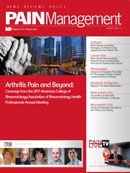Successful Low Back Pain Treatment Remains a Challenge
Low back pain is one of the most frequently reported reasons for why patients visit their doctor, with lifetime prevalence as high as 60-80%. However, despite the availability of a wide range of treatment modalities and several published guidelines, outcomes for patients with low back pain are often unsatisfactory.
Low back pain exacts a significant physical and financial toll on patients in the US, resulting in millions of office visits and billions of dollars in direct and indirect costs as patients seek relief. In “Diagnosis and Treatment of Low Back Pain: A Joint Clinical Practice Guideline from the American College of Physicians and the American Pain Society” (http://bit.ly/quXMfm), Chou and colleagues noted that low back pain is the fifth most common reason for all physician visits in the United States, with one in four US adults reporting experiencing low back pain lasting at least one full day in the previous three months. An article published in JAMA in 2008 (http://bit.ly/pyUzYm) on the costs associated with back pain claimed that low back pain alone accounted for about 2% of all physician office visits in 2005.
There is a large and growing number of treatment options for low back pain from which patients and clinicians can choose, including nonpharmacological options (massage, exercise, cognitive behavioral therapy, spinal manipulation, etc), medications (NSAIDs, acetaminophen, opioids), injections, and surgery. However, Chou et al. noted that despite the availability of these options for the evaluation and management of low back pain, “There has been little consensus, either within or between specialties, on appropriate clinical evaluation and management of low back pain,” with many studies showing “unexplained, large variations in use of diagnostic tests and treatments.” Yet, “Despite wide variations in practice, patients seem to experience broadly similar outcomes,” due to a variety of factors that perhaps include the self-limiting nature of many forms of back pain and the limited efficacy of some interventions.
APS Guidelines for Interventional Therapies, Surgery, and Interdisciplinary Rehabilitation for Low Back Pain
The panel that created the revised APS guidelines found that evidence for the use of a number of interventional diagnostic tests, therapies, and surgery interventions was “mixed, sparse, or not available,” and offered eight recommendations “to help determine the best way to treat patients with low back pain,” including:
- Consider “intensive interdisciplinary rehabilitation with a cognitive/behavioral emphasis for patients with nonradicular low back pain” who do not respond to usual treatment.
- Avoid the use of facet joint corticosteroid injection, prolotherapy, and intradiscal corticosteroid injections for patients with persistent nonradicular low back pain.
- Engage in shared decision making and discuss with patients the risks and benefits of interventions such as surgery, epidural steroid injections, and spinal cord stimulation. Discuss the evidence showing the effectiveness (or lack thereof) for some of these options and compare them with other, less invasive treatment options. Access the summary that accompanied the 2009 publication of the revised APS guidelines for low back pain (http://bit.ly/outkpS) for more information. A complete review of the evidence used in the creation of the guidelines is available online (http://bit.ly/kOU9Hh).
Foster, in “Barriers and Progress in the Treatment of Low Back Pain,” published in BMC Medicine (http://bit.ly/rjTtMt), also commented on this phenomenon, noting that although “many practice guidelines are now available to help practitioners choose treatments that are safe and effective,” there is no treatment that has “large, significant and consistent benefits for patients with non-specific [low back pain].” For most patients with non-specific low back pain, “The reality is that the treatments we have to offer tend to produce small effects, often only in the short term and none appear to effectively change long-term prognosis.”
The comparatively limited efficacy of most available treatments for treating low back pain is only one reason for the poor outcomes often seen among this patient population, especially in the primary care setting. The inconsistent application of evidence-based clinical guidelines in practice is also to blame. For example, according to Foster, “We know that early access to advice and information about self-management and some specific treatments such as exercise, manual therapy, acupuncture, and cognitive-behavioral interventions are effective, yet most patients in primary care actually receive symptomatic care through advice related to the current episode and medication alone, neither of which has a clear focus on secondary prevention. Another example is return to work advice, where just under a third of health care practitioners continue to recommend staying off work to patients for whom guideline recommendations suggest the opposite.”
Improving outcomes in this population will require greater awareness among physicians of the strength of the evidence supporting the use of specific treatments and their limitations, risks, and benefits; incorporation of a thorough history and physical exam during differential diagnosis to facilitate “diagnostic triage” of patients into broad subcategories of low back pain; and more diligent application of best practice recommendations and clinical guidelines.
